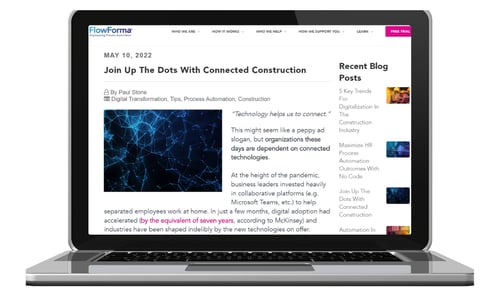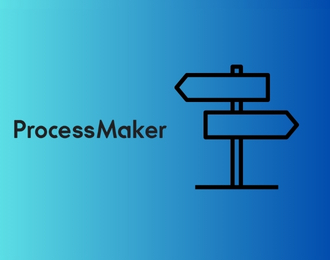Organizations across the globe are turning to digital transformation. The construction industry is no exception, and business leaders are seeking out new technologies to solve specific challenges.
In such a competitive market, acceleration is key. Finding the right digital solutions and deploying them quickly is a priority for business leaders.
Now that digital transformation is underway in the construction industry, it’s not enough to think about deployment. With so much competition in the market, and other businesses digitizing at speed, acceleration should be a priority.
In this blog, I will provide an overview of digital transformation in construction and actionable tips and strategies to apply to your organization. Let's get started!
What is Digital Transformation in the Construction Industry?
Digitization in the construction industry has been hailed as the secret to growth, and a revenue generator for well-digitized incumbents.
According to research from McKinsey, the top ten percent of companies with the largest digital revenue account for up to 80 percent of digital revenue generated in their sector. It notes that “superstar” businesses have committed large resources to digitization both in terms of investment and developing a digital workforce. And the investment has paid off. In short, business leaders are seeing a positive correlation between digitization and profitability.
Construction firms should take note of this trend – and digitize fast. Rapid digitization yields impressive results, and in a market where digitization is becoming rife, it’s important that construction firms join the digitization movement. Digital transformation in the construction industry is happening and businesses must accelerate their digitization efforts to stay competitive.
Digital transformation in the construction industry has been slow compared to other sectors. In the last few years, however, business leaders have begun to sit up and take notice. The technologies to support digital transformation have developed significantly over the last ten years and have been designed to meet specific construction needs.
Examples of Digital Transformation in Construction
At the moment, five key trends underpin digital transformation in the construction industry. Examples are:
- BIM – or “building information modeling” is quickly becoming standard practice for construction firms through the industry. BIM technology joins up a fragmented value chain and creates visibility across the construction lifecycle, connecting project data, teams, and workflows.
- Digital documentation – in construction projects, there is a consistent flow of large, complex documents. Using digital documentation rather than manual methods (email/ pen and paper) ensures a better flow of documentation and visibility over data throughout the value chain.
- Mobile-first tools – construction projects take place on remote sites, where digital technologies are difficult to deploy. Also, the sites often have minimal access to the internet. Using construction software on a mobile device (like FlowForma’s mobile app) allows construction workers to access project data “on the fly” and fill out data forms in offline mode.
- Process automation – construction firms operate using so many processes. Digitizing these creates a large uptick in productivity and ensures that businesses can stay compliant with industry regulation and internal governance. With process automation, construction firms can fast-track processes and unlock savings across the project lifecycle.
- Data software – over the lifecycle of a project, a wealth of data will be produced. This will include design model information, cost estimates, and process insights. Using a connected data repository joins up project data in one central environment and gives business leaders a holistic picture of operations.
Digital Transformation Trends in Construction Industry
The urgent need for digital tools during the pandemic gave business leaders a crash course in digitization. Now, acceleration is sought after rather than required.
When it comes to digital transformation, we know that acceleration generates profitability. However, business leaders in construction are still unsure of how to speed up their digital transformation efforts.
There are several practices that construction business leaders can undergo when accelerating their digital transformation journeys. These practices will ensure a more accelerated and streamlined pilot stage and deployment process.
Learn more about the key digital transformation trends in my recent webinar hosted in partnership with Engineering News Record (ENR).
1. Focus on fixing specific pain points
Rather than choosing a one-size-fits-all solution, it’s important that construction business leaders think about the specific pain points of their employees. Construction projects are unique, and needs can vary across the lifecycle depending on the nature of a project. It’s important that business leaders think about where the core of their business lies and whether a digital solution meets the specific pain points of employees.
Example: Morgan Construction believes that the core of their business lies in their contractors and employees. The team quickly realized that the company had a high number of individuals being onboarded to work on the various oilfield sites they serve.
Morgan Construction believes that the core of their business lies in their contractors and employees. The team quickly realized that the company had a high number of individuals being onboarded to work on the various oilfield sites they serve.
To manage the onboarding process, they had, historically, relied on an Excel spreadsheet. As part of their digital transformation efforts, they switched to FlowForma’s Process Automation tool instead.
This fast-tracked the process, removed the chance of human error, and made onboarding easy to iterate (which was important, given its frequency).
The result:
Morgan Construction has since grown as a business, without new positions added. The team is now better organized and sees time savings across projects, with process automation in place. Their specific pain point has been resolved and a key part of their operations streamlined, almost overnight.
2. Use tools that promote collaboration
Construction projects are different to projects in most other sectors. They are typically fragmented along the value chain, with multiple contractors/ subcontractors/ engineers/ stakeholders, etc. involved at each stage. As a result, collaboration across a construction project’s lifecycle is difficult.
A connected construction tool is one that promotes collaboration across the value chain. It will almost certainly be BIM compliant and serves to help employees communicate better during the project lifecycle.
What to focus on:
Construction business leaders should pay attention to processes that involve multiple disciplines and groups. The digital solutions they implement should smooth interactions between these teams.
Example:
The process of requesting materials on-site typically involves the Site Manager, the Requisition team, and a team that supplies materials. A request that starts on-site goes through various stages of communication before ending up with a supplier. If there is even one error down the line of communication (many construction teams still rely on email or Excel spreadsheets), this can lead to inaccurate orders and subsequent project delays.
Using a connected construction tool unites information in one place, contains specific data entry forms for accurate information, and fast-tracks activities like material requests.
3. Reskill teams
A mistake many construction leaders make is to implement digital solutions without the operational change required alongside. It’s not enough to install new technologies. As much time needs to be spent on reskilling teams and restructuring processes (if, for example, process automation removes a manual activity or stage of the process).
Too often, as noted by McKinsey, attempts to streamline projects with digital solutions fail because of this. Those technologies which are successfully deployed at the pilot stage (on a smaller scale) cannot be fully integrated into the broader scale of the business. It’s important that construction business leaders invest in training for digital solutions and choose solutions that can be easily deployed and used (and therefore require minimal training).
What to focus on - The no code movement: No code is an approach to software development that requires no coding skill to build an application.
No code is an approach to software development that requires no coding skill to build an application.
Construction business leaders are, increasingly, turning to no code digital solutions. Digital transformation in the construction industry needs to be accelerated, and no code solutions are a failsafe way to implement new technologies with ease.
No code digital solutions, like FlowForma’s no code tool:
- Rapidly digitize manual processes
- Deliver a swift ROI
- Empower construction employees
- Drive project efficiency through connected construction
- Don’t require coding or IT skills
- Require minimal training for employees to get up and running
Adoption of the FlowForma no code tool is rapid because the tool is intuitive (and mobile friendly). Since it’s easy to use, construction employees enjoy working with the tool.
Example:
One example of the simplicity and impact of using FlowForma’s no code process automation tool is from Sullivan Engineering, a FlowForma customer. Rolling out FlowForma to new users took the company a quarter of the time it took to deploy other solutions and the outcomes have been game-changing for their business.
Sullivan Engineering found it much easier to review processes and train people on them; everything is now in one place with seamless document control, as opposed to old processes where there could be multiple versions in different places.
Result:
Sullivan Engineering has reaped the benefits and now saves up to 700 hours per year on repetitive tasks. Watch the Sullivan Engineering webinar to learn more.
4. Prioritize flexible working
The acceleration of digital transformation in the construction industry is underpinned by technologies that support remote work. Construction projects are executed in scattered locations across the value chain (various offices, home settings, remote construction sites).
Construction business leaders might invest in impressive digital solutions, but if the technologies rely on robust pieces of hardware to function, they cannot be deployed quickly (and in some cases, not at all).
What to focus on: A mobile-first mentality
Since construction work takes place on remote and harsh terrain, deploying hardware is not a viable option. Acceleration of digital solutions is better achieved, then, by prioritizing systems that run on mobile-first devices. These technologies allow construction workers to stay connected and in the know from any workplace – whether on site or at home.
Benefits Of Digital Transformation In The Construction Industry
The benefits of digital transformation in the construction industry are clear. More than that, they should be used as a strong reason for acceleration, or you risk falling behind competitors that move to digital solutions. Here are four clear benefits:
- Uptick in productivity – digital transformation is positively linked with productivity. A connected construction platform joins up teams across the value chain. It accommodates the back and forth that is so prevalent in construction and promotes a more streamlined (faster) way of working.
- Safe operations – digital tools are typically BIM compliant, helping construction firms to meet regulations and stringent health & safety rules. For example, using an online form (as part of a digital tool) for data entry removes the chance of human error. For construction workers completing a Risk Assessment or Incident Report Form, accurate data improves safety and compliance on each project.
- Improve communication – effective communication is a challenge for construction teams, scattered across the value chain and operating in dispersed locations. Using a connected construction platform, in which data suddenly becomes visible across a project lifecycle – and information quickly shared – is transformative.
- Data-driven business decisions – without visibility over project data, it can be hard for construction business leaders to make long-lasting and tangible business decisions. Digital transformation in the construction industry is the antidote for this. Digital solutions give access to data, which leads to insights and helps business leaders to put in place more effective processes, activities, and solutions.
- Avoid delays - digitalization will help avoid delays in construction projects as you can address bottlenecks in real-time.
- Visibility across building construction and road construction projects with enhanced analytics and tracking.
Why is it Important to Digitally Transform in Construction?
Those construction firms which need to deploy solutions fast, and at scale, should deploy process automation technologies as a priority.
Process automation fast-tracks processes across a business. It removes manual, time-intensive processes and replaces these with streamlined, transparent systems.
How to Digitalize in Construction?
Process automation is the key to early-stage digital transformation and acceleration. It unlocks cost savings, produces a vast uptick in productivity, and can be seen as a vital first step in any digital transformation journey. Benefits include:
- Rapid adoption
- Processes digitized in weeks, not months
- ROI within 6 weeks
- Cross-departmental
- Mobile-first applicability
- Improved data quality and visibility
- Improved productivity Short-term gains/ long-lasting benefits
Accelerate Digital Transformation In Construction With Process Automation
FlowForma is well-placed to help construction firms accelerate their digital transformation journey. FlowForma’s award-winning tool supports and facilitates:
- BIM compliance
- Digital documentation
- Mobile-first technology
- Process automation
- Data visibility
With FlowForma’s no code solution, your firm is empowered to digitize at speed. IT and coding skills are not required, manual processes can be digitized 5-10 times faster than other tools, and ROI outcomes appear in as little as six weeks.
Conclusion
With the world transforming at speed, it’s time that construction firms catch onto the acceleration trend. Fast-track digitization now and see your business go from strength to strength.
Drive rapid digitization with FlowForma process automation. Register for your Free Construction Trial today!
.png) By
By 








